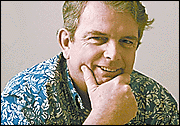Advertisement - Click to support our sponsors.


The Way I See It
COMING from New England, where we have plenty of monuments and most are sacred, I never understood the talk of tearing down the Waikiki War Memorial Natatorium. Treasures of an
era long agoIn a state like Hawaii, where most architecture is recent in comparison to the rest of the United States, this edifice always looked worth preserving.
I didn't always know what it was.
When I first saw it in 1975 as a 25th Infantry Division soldier, I thought it looked like half of a coliseum sitting in the water.
It was an extraordinary fixture on the Waikiki coastline.
So, I took the four-mile walk from my residence to the reopening ceremonies for the facade of the memorial Sunday. And I was glad to see the old-fashioned reverence accorded the structure built to commemorate Hawaii's contribution to World War I.
But WWI was not the only inspiration for the natatorium. Hawaii enjoyed world prominence in swimming at the time.
That's an era long gone. The state hasn't even had an Olympic swimmer since 1976 and the last medal by a locally born Olympian was won in 1968.
But when the natatorium went up, it was not unusual to see more than one Hawaii swimmer in the Olympics.
Duke, Sam and David Kahanamoku, Warren Kealoha and Pua Kealoha (not brothers) all made the team that went to Antwerp in 1920. George "Dad" Center, also from Hawaii, was an Olympic assistant swim coach in Antwerp.
There was a 1-2-3-4 finish for Hawaii swimmers in the 100-meter freestyle swim that year.
Then along came Buster Crabbe, who competed in the next three Olympics and went on to become Tarzan, Flash Gordon, Buck Rogers and Captain Gallant in the early days of "talkies."
After World War II, Hawaii's place in Olympic swimming was maintained by Thelma Kalama Aiu (1948), Bill Smith (1948) , Ford Konno (1952, 1956), Bill Woolsey (1952, 1956) and Evelyn Kawamoto (1952).
Keala O'Sullivan Watson (1968) won a bronze for springboard diving and that was the end of the medal flow to the islands.
I don't know how many of the surviving Hawaii-born Olympians performed at the natatorium.
But I doubt that anyone alive performed there as long ago as Aileen Riggin Soule.
SOULE won gold for springboard diving in 1920, and a silver for the springboard and bronze for the 100-meter backstroke in Paris in 1924.
In March 1930, when she arrived in Honolulu aboard an ocean liner named the President Garfield, she'd been a pro for six years. She'd played the Hippodrome and toured with English Channel swimmer Gertrude Ederle.
It was the beginning of a world tour which was a sort of working vacation for Soule. She got paid to perform in Japan, Egypt, Spain (with Johnny Weismuller) and England. But in Honolulu, she dived for free.
"It was a local meet," said Soule, who already had a fondness for island people. "There were a lot of people that day in the stands. They were very enthusiastic about swimming back then."
Soule, now the world's oldest living individual gold medalist, couldn't make it to the reopening Sunday.
But her heart was there.
She performed only once at the natatorium, but she attended many meets there after moving here in 1957.
"It was an eyesore and I'm so glad they're fixing it," she said.
Soule and the natatorium have something in common. They're both treasures of an era we shouldn't forget.
Pat Bigold has covered sports for daily newspapers
in Hawaii and Massachusetts since 1978.